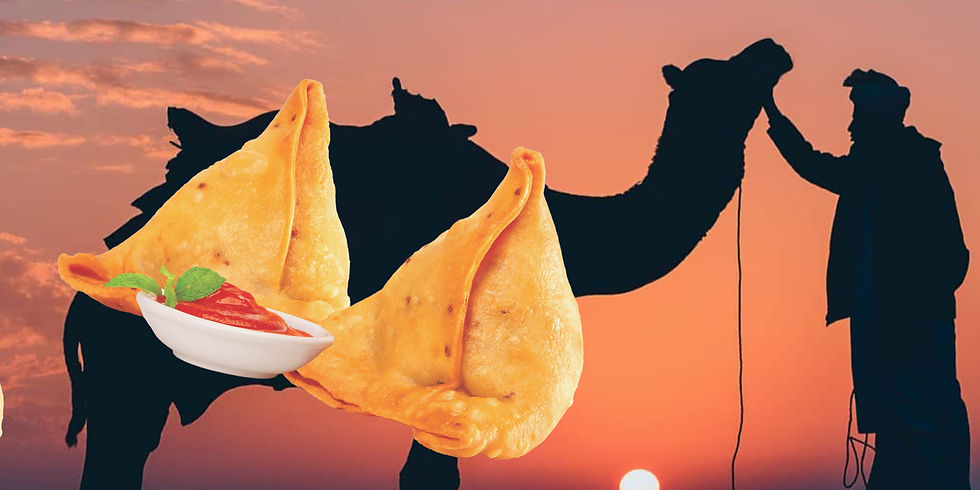15 Indian Foods with Surprising Global Roots: From Persia to Portugal and Beyond
- pghosh131426
- May 30, 2023
- 3 min read

Unveiling the Global Journey of Indian Cuisine: A Story of Cultural Exchange and Culinary Fusion
Indian cuisine is synonymous with a symphony of flavors, a vibrant blend of spices, and a rich diversity that mirrors the nation. However, you may be surprised that numerous elements considered quintessentially Indian trace their roots back to foreign soils. This gastronomic journey offers a unique perspective on the universal language of food and the power of cultural exchange.
India's culinary culture is a splendid mosaic of influences, ranging from the Middle East to Europe and China. Traders, explorers, colonizers, and immigrants didn't just bring tangible goods but also introduced their ways of life, thus profoundly shaping India's culinary scene. Today, we'll take a gastronomic journey back in time, exploring 15 popular 'Indian' foods and their intriguing international origins.
Unraveling the fascinating journey of these foods and ingredients reminds us of our global culinary heritage's interconnected nature. It's a story that resonates with our increasingly globalized world today, symbolizing unity in diversity.
Through this exploration, we discover that food is essential for cultural exchange, facilitating understanding and appreciation between cultures. The history of Indian cuisine, richly woven with foreign influences, exemplifies this culinary cross-pollination.

Chai: This beloved Indian beverage is actually of Chinese origin. Tea was a medicinal herb during the Zhou Dynasty in China. The British popularized it in India during the 19th century to break the Chinese monopoly on tea.

Jalebi: This ubiquitous Indian sweet, characterized by its spiraled, crispy structure and sugary syrup, traces its origins to the Middle East. Known as 'Zalabia' in Arabic, this sweet treat was brought to India by Persian traders.

Samosa: This popular Indian snack originated in the Middle East before the 10th century. Originally named 'sambosa', they were introduced to the Indian subcontinent by traders from Central Asia.

Biryani: This immensely popular and flavorful dish came to India with the Mughals. It is believed to have originated in Persia and was brought to India by Mughal emperors, where it adapted local flavors and ingredients.

Rajma: Rajma, or kidney beans, a staple in North Indian cuisine, is native to Central and South America and was brought to India through Portuguese and Spanish explorers.

Gulab Jamun: Another popular Indian sweet, gulab jamun, surprisingly has its roots in the Mediterranean region and Persia. It was brought to India by Persian invaders and has since become a staple in Indian celebrations.

Pav Bhaji: The beloved Mumbai street food, Pav Bhaji, has Portuguese influence. The bread, or "pav," comes from the Portuguese word for bread, 'pão.' The Portuguese introduced this bread to India during their colonial rule in Goa.

Vindaloo: This fiery dish from Goa was brought to India by Portuguese explorers. Originally, the dish was a mild stew made with meat, wine, and garlic, but it transformed into a spicy curry when local Goan cooks replaced the wine with palm vinegar and added local spices.

Filter Coffee: South Indian filter coffee isn't originally Indian. Coffee was brought to India by an Indian Muslim saint, Baba Budan, from Yemen in the 17th century.

Naan: Despite being a staple of Indian cuisine, naan was originally a Persian bread. It was brought to India by the Mughals and found a permanent place in the Indian culinary scene.

Paneer: As surprising as it may sound, paneer was not a part of traditional Indian cuisine. It was introduced to India by the Portuguese and the British. Indians embraced it wholeheartedly, which is now an integral part of Indian vegetarian cuisine.

Chingri Macher Malai Curry, or Shrimp Malai Curry, is a staple Bengali dish with surprising Malaysian roots. 'Malai' comes from 'Malay,' and Malaysian sailors likely brought the recipe to the Bay of Bengal. The dish, which uniquely uses creamy coconut milk rather than dairy, has become a beloved signature dish in West Bengal and is noted for its mild and flavorful taste.

Hakka Noodles: A popular dish in Indo-Chinese cuisine, Hakka noodles originate in the Chinese Hakka community. It was introduced in India by the Chinese immigrants who settled in Kolkata.

Balti Chicken: "Balti" cuisine started in the Birmingham area of England in the 1970s when the South Asian communities began to make their mark on the British food scene. Balti Chicken or Balti Gosht became famous for its quick cooking process, similar to a stir-fry, and its flexibility to be adapted to British tastes. Today, this dish is enjoyed in India and across the globe, adding another layer to the cultural and culinary exchange.

Chicken Tikka Masala: This widely loved dish was not born in India but in Glasgow, Scotland. A chef of Indian origin reportedly prepared it to appease a British gentleman who found the chicken tikka too dry.
The origins of these dishes emphasize the dynamic nature of cultural exchange and the unifying power of food. Indian cuisine, with its diverse foreign influences, represents an embrace of this cultural synthesis, symbolizing unity in diversity. This sentiment echoes beyond the realm of food and resonates in our globalized world today.







Comments